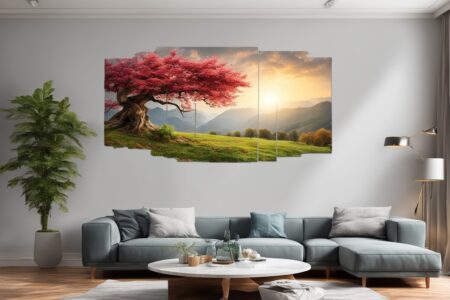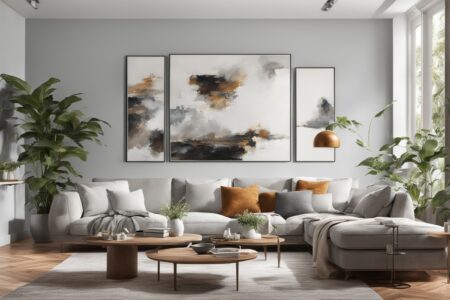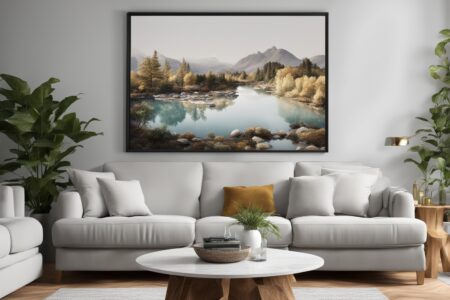Elevating Your Space: Innovative Room Art Ideas for 2023
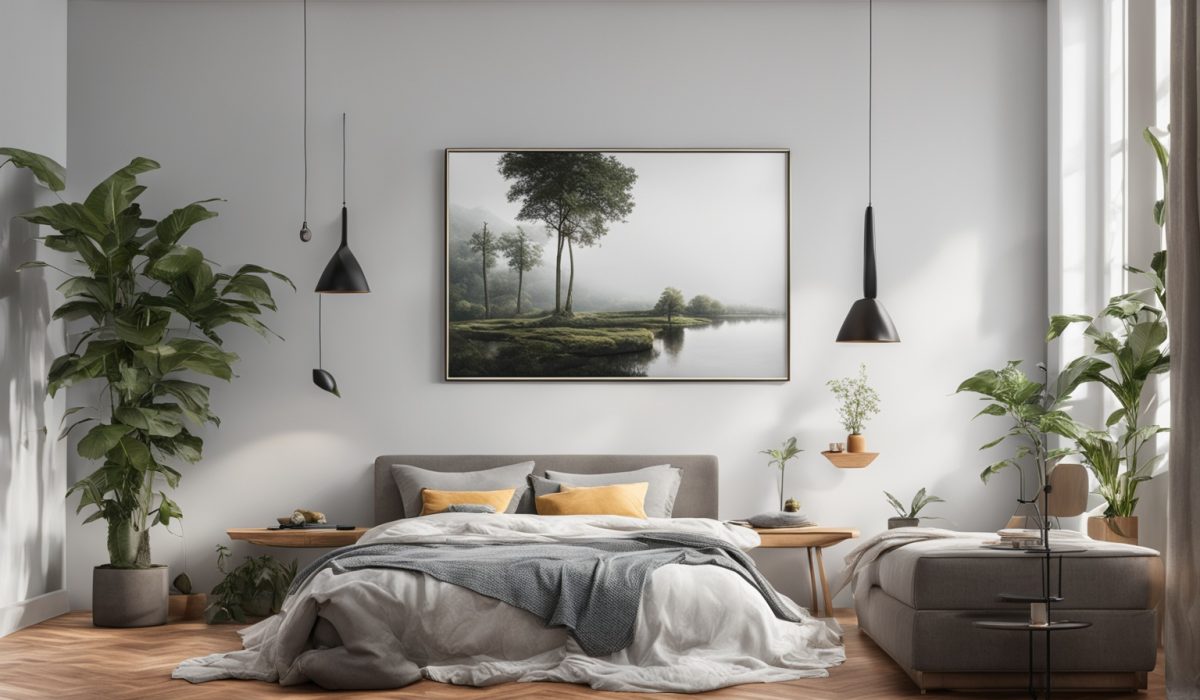
As we step into 2023, the desire to refresh and reinvent our living spaces becomes ever more pressing. One of the most powerful ways to transform any room is through strategic use of art. The ambience of your home changes dramatically with the introduction of vibrant or subtle art pieces that act as focal points or complementary accents. Selecting the perfect piece involves understanding not just what you like, but also what works for the space in terms of size, colour, and style. Colour plays a crucial role, either enlivening a room with bold hues or soothing it with softer tones.
With the plethora of current trends offering everything from minimalist monochrome to eclectic mixes of different art styles, the possibilities are endless. Even those confined by smaller spaces can find clever strategies to showcase art that reflects their personality and enhances their living environment. Beyond aesthetics, the practicalities of maintaining the quality and look of room art over time, choosing sustainable art options, and the logistics of art installation, whether done personally or with professional help, are all elements that need consideration. Furthermore, embracing local art not only supports the community but also adds a unique touch that cannot be replicated.
Each choice made in the selection, placement, and upkeep of room art contributes to a more personalised and dynamic space, promising a fresh look for the new year.
CONTENT
Understanding the Impact of Room Art on Ambience
Creating Emotional Appeal
Room art can dramatically influence the emotional tone of a space, serving either to soothe or energise the inhabitants. For example, landscapes and soft abstract pieces often impart a sense of calm and are ideal for bedrooms and study areas. Conversely, vibrant and bold artworks can energise high-activity areas such as living rooms or creative studios.
Influencing Perceptions of Space
Art can alter the perceived dimensions of a room. Darker, larger-scale paintings might make a space feel smaller and more intimate, while light-coloured and smaller artworks tend to open up a room, making it appear larger. Strategic placement of art pieces can optimise the visual impact, enhancing the room’s spatial qualities without the need for structural changes.
Enhancing Room Themes
Art plays a pivotal role in reinforcing or defining the theme of a room. Whether aiming for a modern chic, rustic charm, or vintage style, the chosen room art can solidify this theme. This cohesiveness helps to create a well-rounded ambience that resonates with the intended aesthetic of the room, ensuring that the environment is both cohesive and visually appealing.
Choosing the Right Room Art for Your Space
When selecting art for your space, it is essential to first consider the size of the area where the artwork will be displayed. Scale and proportion play crucial roles; a large, expansive wall may benefit from a sizable piece or a collection of smaller pieces grouped together for visual impact. On the other hand, a small, delicate piece may be perfect for a more intimate setting or a narrow wall. Measure your space and envision how a piece will fit before making a purchase to avoid overwhelming or underwhelming the room.
Another vital factor in choosing the right room art is the existing decor and colour palette of the space. Art should complement the room’s style and colours unless you aim for a striking contrast. Observe the dominant and accent colours in your room, and consider artworks that either harmonise with these tones or add a thoughtful pop of colour. Art isn’t just about visual appeal; it should integrate well with the overall design scheme to enhance the space harmoniously.
Finally, consider the lighting available in the area where the art will be placed. Natural light can dramatically affect the appearance of art throughout the day and should be considered when placing pieces around windows or in brightly lit rooms. If the artwork is in a darker area of the home, think about adding focused lighting, such as picture lights or spotlights, to enhance visibility and impact. Proper lighting ensures that the artwork is a central point in the room’s composition, offering maximum aesthetic benefit.
The Role of Colour in Room Art Selection
Setting the Mood with Colour
Colours in artworks influence the mood and atmosphere of a room. Cool tones like blues and greens are known for their calming effect, making them ideal for bedrooms and bathrooms where tranquility is desired. Conversely, warm colours such as reds and yellows invoke energy and vibrancy, perfect for living spaces and kitchens where dynamic interactions occur. Selecting the appropriate colour palette in art can reinforce the desired emotional undertone of any given space.
Complementing Interior Design
Colour coordination between room art and the room’s existing design elements is crucial in creating a visually cohesive space. Art pieces that reflect or complement the primary and secondary hues of the room’s decor help to tie the room together. This approach doesn’t require exact matching but rather embracing shades that echo textiles, furnishings, or other decor items, thus making the art feel integrated and intentional within the space.
Using Colour to Enhance Spatial Perception
Colour not only defines style but also manipulates space perception. Lighter colours and pastels can make small rooms feel larger and brighter, as they are naturally more reflective. Darker hues create a sense of intimacy and are suitable for larger spaces that need to feel more enclosed. Consider the impact of colour in your art choices to optimise the perceived size and feel of a room, effectively using hues to make spaces more inviting and suited to their function.
Current Trends in Room Art for Modern Homes
One emerging trend in modern home art is the growing inclination towards minimalist abstract pieces. These artworks typically feature simple, geometric shapes and a restrained colour palette, creating a clean and sophisticated look that complements contemporary interior design. The appeal lies in their ability to blend seamlessly with modern decor while still making a subtle, stylish statement. This trend not only elevates the aesthetic of any room but also underscores a preference for art that embodies clarity and simplicity in its expression.
Another notable trend is the incorporation of digital and mixed media art into room designs. As technology intertwines more with everyday life, digital artworks offer a dynamic and interactive element that traditional paintings cannot. Whether it’s digital canvases that change visuals or pieces that incorporate light and motion, these innovative art forms cater to a tech-savvy generation while adding a unique, modern twist to room decor. This blend of technology and art is perfect for creating focal points in a room that captivate and start conversations.
Finally, there is a resurgence of interest in artisan-crafted pieces that tell a story. In a world increasingly dominated by mass-produced items, custom-made or handcrafted art pieces offer individuality and authenticity. These pieces often reflect a cultural heritage or personal journey, bringing depth and personality into modern homes. Whether it’s a hand-woven tapestry or a custom sculpted piece, incorporating these elements provides not only visual interest but also a sense of connection and heritage within a space.
How to Mix and Match Different Art Styles
Understanding the Basics of Art Coordination
Mixing and matching different art styles begins with a basic understanding of coordination. By recognising the underlying themes, colours, or subjects that your chosen pieces have in common, it’s possible to create a harmonious display even out of diverse styles. This coordination can be subtle, focusing on nuances such as similar frame styles or colour accents, and helps disparate pieces look planned and intentional rather than haphazard.
Creating Focal Points
When blending various art styles, identify one or two pieces to serve as focal points. These primary pieces should ideally be bolder or larger, anchoring the collection and drawing in the viewer’s attention. Surrounding artworks should complement and enhance these central pieces without overpowering them. This approach helps in maintaining a visual hierarchy in your space that guides the eye smoothly from one artwork to another.
Balancing Scale and Proportion
An effective mix of different art styles often requires careful consideration of scale and proportion. Ensure that larger, statement pieces are balanced with smaller, subtler works to maintain visual balance. Arranging artworks in such a way that they lead the viewer through the space can also help in creating a balanced interior. Remember, the goal is to enhance the aesthetic appeal of the room without overwhelming the senses.
Strategies for Placing Art in Small Spaces
Placing art in small spaces requires thoughtful consideration to ensure the area does not become overcrowded, yet still benefits from artistic flair. One effective strategy is to use vertical space, which is often underutilised. Positioning artwork vertically can draw the eye upward, making the ceilings appear higher and the room larger. Opting for slimmer, vertical pieces or arranging several smaller pieces in a vertical sequence can maximise impact without taking up valuable floor or wall breadth that could contribute to a cluttered feeling.
Another approach is to choose art pieces that incorporate mirrors or use reflective materials. Mirrored art or pieces with glossy finishes help bounce light around the room, creating a sense of depth and openness. This is particularly advantageous in spaces with limited natural light. Such artworks not only serve as decorative elements but also function practically to make the room appear more spacious and airy.
Lastly, consider the colour scheme and content of the artwork when decorating a small space. Light hues and serene subjects, such as landscapes or abstract pieces with soft colour gradients, can create a calming effect and visually expand a room. It’s important to keep the artwork in proportion to the furnishings and overall scale of the space, ensuring that each piece contributes positively to the perception of size rather than making the area feel confined.
Maintenance Tips for Keeping Your Room Art Fresh
Regular Cleaning and Dusting
Maintaining the freshness of room art starts with regular cleaning to remove dust and dirt that can accumulate and dull the artwork’s appearance. Use a soft, dry microfiber cloth to gently wipe the surface of paintings and framed pieces. For sculptural art or textured paintings, periodic gentle vacuuming using a brush attachment can prevent dust build-up in crevices and on surfaces, ensuring the artwork remains vibrant and detailed.
Optimal Environmental Conditions
Artworks are sensitive to environmental conditions; thus, maintaining optimal humidity and temperature is crucial to preserve their longevity. Avoid placing art in direct sunlight, near heating vents, or in damp areas to prevent fading, warping, or mould growth. Use climate control where possible, especially with delicate materials like paper or textiles, aiming for a consistent temperature and moderate humidity to keep art in pristine condition.
Professional Framing and Protection
Investing in professional framing services can significantly contribute to the longevity of room art. High-quality frames not only enhance the visual appeal of the artwork but also offer protection against environmental damages. Consider using UV-protective glass to prevent fading caused by light exposure. Additionally, ensuring that the artwork is securely mounted in the frame, and occasionally inspecting the backing and hanging fixtures can prevent future damage and maintain the artwork’s condition over time.
Incorporating Local Art into Your Room Design
Incorporating local art into room design not only personalises your space but also supports and celebrates the cultural identity and creativity of your community. Opting for pieces from local artists provides a unique story to your home décor, adding depth and authenticity that mass-produced items simply cannot offer. These art pieces often reflect the local landscape, traditions, or urban vibe, allowing you to foster a stronger connection with your surroundings. Furthermore, local art can be a conversation starter, offering a personal connection to the space that guests and family members can appreciate and engage with.
Choosing local art also opens up the opportunity to directly interact with artists, giving you insight into the creative process and the satisfaction of supporting someone in your own community. Attending local galleries, art shows, or art fairs can be a delightful way to discover new artists and see their work firsthand. Additionally, these interactions often allow for custom commissions, where you can collaboratively work with an artist to create a piece that is perfectly tailored to your space and personal taste, making your room design genuinely one-of-a-kind.
Moreover, integrating local art into your decor can be part of a broader strategy that emphasises sustainability. By purchasing locally, you reduce the environmental impact associated with transporting art pieces from distant locations. This approach not only supports the local economy but also promotes environmental responsibility. Each piece holds its unique charm and contributes to creating a more personalised and connected living environment, enhancing the overall aesthetic of your home while upholding values that benefit the community and the planet.
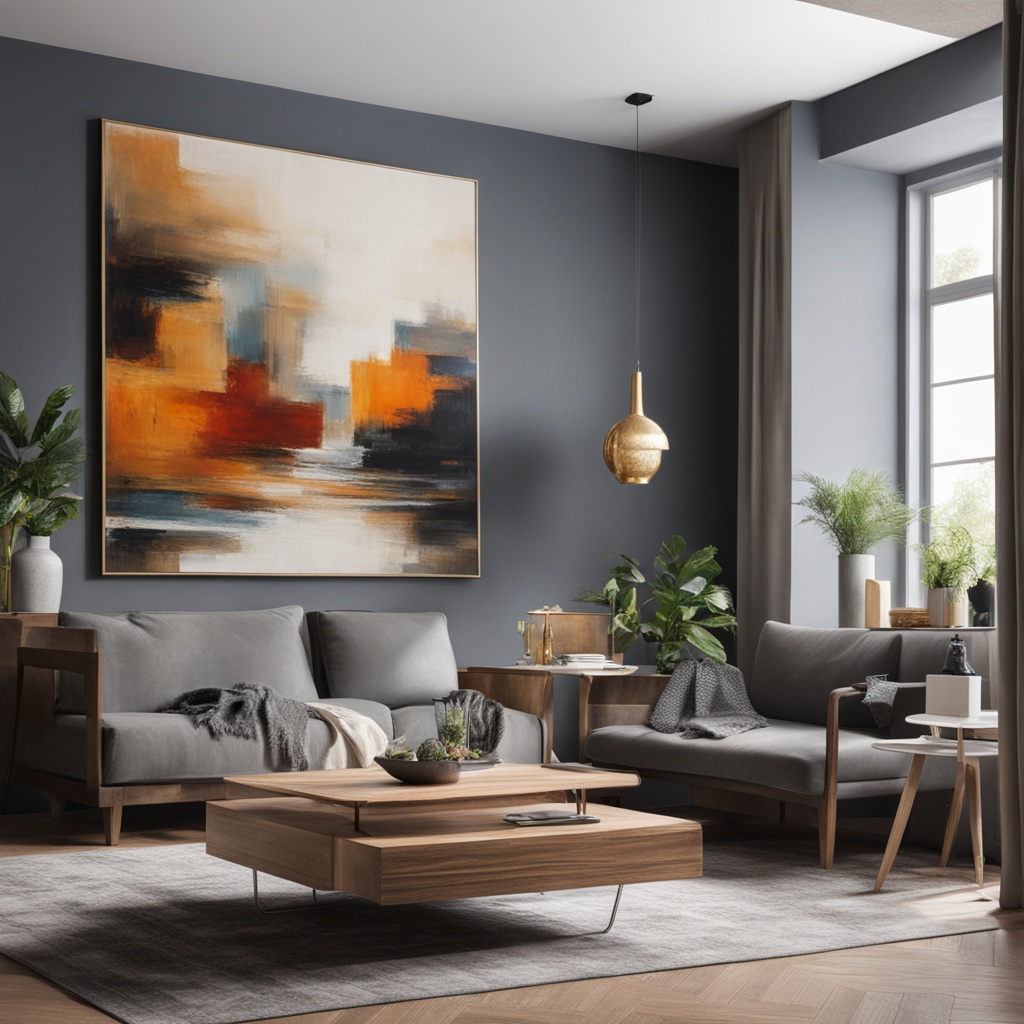
Sustainable Practices in Choosing Room Art
Opting for Eco-Friendly Materials
When selecting room art, considering the sustainability of the materials used can significantly impact environmental conservation. Look for artworks created from recycled or upcycled components, such as reclaimed wood frames or sculptures made from repurposed metals. Many artists also utilise natural, non-toxic paints and other materials that are kinder to the environment. By choosing these eco-friendly options, you not only acquire a unique piece of art but also contribute to reducing harmful waste and the depletion of resources.
Supporting Local Artists
Purchasing art from local artists reduces the environmental costs associated with transporting goods over long distances. This practice lessens your carbon footprint and also bolsters the local economy by supporting regional creators. Local artists often draw inspiration from their immediate environment, providing pieces that resonate with the cultural and natural elements of the area. This approach ensures your room art is not only sustainable but deeply connected to your local setting.
Engaging in Art Sharing and Rotation
Adopting a rotating art scheme can be an innovative way to keep your decor fresh without continually purchasing new pieces. This can involve setting up an arrangement within your community to borrow and lend art, ensuring that pieces are continually appreciated and not left stored away. Art-sharing initiatives or joining art clubs can also facilitate this exchange, increasing the lifespan and viewer enjoyment of each piece while maintaining an eco-conscious approach to home decoration.
Art Installation: DIY vs Professional Advice
Deciding between DIY and professional art installation involves weighing the complexity of the task against your skill level and the value of the artwork. For simpler installations, such as hanging framed prints or lighter pieces, the DIY approach can be quite sufficient and cost-effective. This option allows you personal satisfaction and flexibility in arranging or rearranging the pieces as you see fit. Using appropriate tools and hardware, such as a reliable level, stud finder, and the correct type of wall anchors or hooks, can ensure your art is securely and neatly displayed, enhancing your room’s aesthetic appeal.
However, when dealing with valuable, heavy, or unusually shaped artwork, professional installation could be the better choice. Experts bring the necessary experience and tools to handle delicate and high-value items, reducing the risk of damage during installation. Professionals can also provide advice on the best placement for aesthetic and conservation purposes, ensuring that the artwork is both visually striking and preserved against potential environmental damages like direct sunlight or humidity.
Moreover, professional advice may prove invaluable when creating intricate art displays, such as gallery walls or installations involving multiple pieces. A professional can offer creative insights and technical know-how that maximise the visual impact of your collection and maintain symmetry and balance. They can also suggest lighting options or protective measures to enhance and safeguard your artwork, making professional installation an investment in the longevity and display quality of your prized art pieces.




